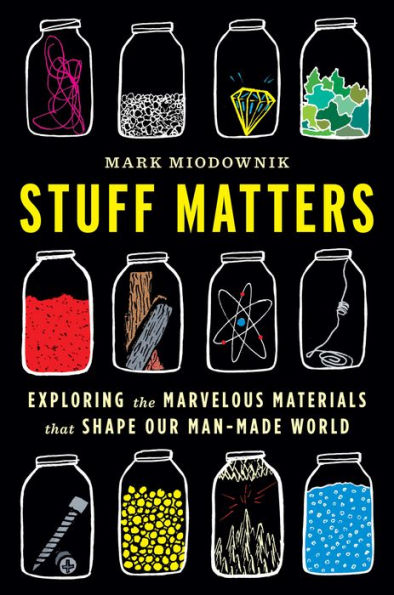The books on this list will challenge you, educate you, and ask you to see the universe in different ways. But they’re anything but dry and academic. On the contrary, they’re lively and approachable, smart and entertaining. Gift them to everyone on your list, read them yourself, and prepare for fascinating discussions this holiday season.
In this New York Times Notable Book, "Mark Miodownik, a materials scientist, explains the history and science behind things such as paper, glass, chocolate, and concrete with an infectious enthusiasm."—Scientific American
Winner of the Royal Society Winton Prize for Science Books
Why is glass see-through? What makes elastic stretchy? Why does any material look and behave the way it does? These are the sorts of questions that renowned materials scientist New York Times bestselling author Mark Miodownik constantly asks himself. Studying objects as ordinary as an envelope and as unexpected as concrete cloth, he uncovers the fascinating secrets that hold together our physical world.
In Stuff Matters, Miodownik explores the materials he encounters in a typical morning, from the steel in his razor to the foam in his sneakers. Full of enthralling tales of the miracles of engineering that permeate our lives, his stories of analysis will make you see stuff in a whole new way.
"Stuff Matters is about hidden wonders, the astonishing properties of materials we think boring, banal, and unworthy of attention...It's possible this science and these stories have been told elsewhere, but like the best chocolatiers, Miodownik gets the blend right."—The New York Times Book Review
1116226377
Winner of the Royal Society Winton Prize for Science Books
Why is glass see-through? What makes elastic stretchy? Why does any material look and behave the way it does? These are the sorts of questions that renowned materials scientist New York Times bestselling author Mark Miodownik constantly asks himself. Studying objects as ordinary as an envelope and as unexpected as concrete cloth, he uncovers the fascinating secrets that hold together our physical world.
In Stuff Matters, Miodownik explores the materials he encounters in a typical morning, from the steel in his razor to the foam in his sneakers. Full of enthralling tales of the miracles of engineering that permeate our lives, his stories of analysis will make you see stuff in a whole new way.
"Stuff Matters is about hidden wonders, the astonishing properties of materials we think boring, banal, and unworthy of attention...It's possible this science and these stories have been told elsewhere, but like the best chocolatiers, Miodownik gets the blend right."—The New York Times Book Review
Stuff Matters: Exploring the Marvelous Materials That Shape Our Man-Made World
In this New York Times Notable Book, "Mark Miodownik, a materials scientist, explains the history and science behind things such as paper, glass, chocolate, and concrete with an infectious enthusiasm."—Scientific American
Winner of the Royal Society Winton Prize for Science Books
Why is glass see-through? What makes elastic stretchy? Why does any material look and behave the way it does? These are the sorts of questions that renowned materials scientist New York Times bestselling author Mark Miodownik constantly asks himself. Studying objects as ordinary as an envelope and as unexpected as concrete cloth, he uncovers the fascinating secrets that hold together our physical world.
In Stuff Matters, Miodownik explores the materials he encounters in a typical morning, from the steel in his razor to the foam in his sneakers. Full of enthralling tales of the miracles of engineering that permeate our lives, his stories of analysis will make you see stuff in a whole new way.
"Stuff Matters is about hidden wonders, the astonishing properties of materials we think boring, banal, and unworthy of attention...It's possible this science and these stories have been told elsewhere, but like the best chocolatiers, Miodownik gets the blend right."—The New York Times Book Review
Winner of the Royal Society Winton Prize for Science Books
Why is glass see-through? What makes elastic stretchy? Why does any material look and behave the way it does? These are the sorts of questions that renowned materials scientist New York Times bestselling author Mark Miodownik constantly asks himself. Studying objects as ordinary as an envelope and as unexpected as concrete cloth, he uncovers the fascinating secrets that hold together our physical world.
In Stuff Matters, Miodownik explores the materials he encounters in a typical morning, from the steel in his razor to the foam in his sneakers. Full of enthralling tales of the miracles of engineering that permeate our lives, his stories of analysis will make you see stuff in a whole new way.
"Stuff Matters is about hidden wonders, the astonishing properties of materials we think boring, banal, and unworthy of attention...It's possible this science and these stories have been told elsewhere, but like the best chocolatiers, Miodownik gets the blend right."—The New York Times Book Review
11.99
In Stock
5
1

Stuff Matters: Exploring the Marvelous Materials That Shape Our Man-Made World
272
Stuff Matters: Exploring the Marvelous Materials That Shape Our Man-Made World
272Related collections and offers
11.99
In Stock

Product Details
| ISBN-13: | 9780544237049 |
|---|---|
| Publisher: | HarperCollins |
| Publication date: | 05/27/2014 |
| Sold by: | HARPERCOLLINS |
| Format: | eBook |
| Pages: | 272 |
| File size: | 30 MB |
| Note: | This product may take a few minutes to download. |
About the Author
From the B&N Reads Blog
